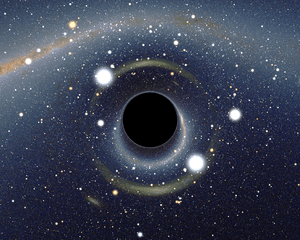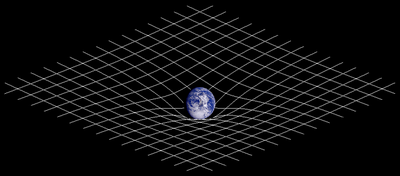Reissner–Nordström metric
| General relativity | ||||||
|---|---|---|---|---|---|---|
 | ||||||
|
Fundamental concepts |
||||||
|
||||||
In physics and astronomy, the Reissner–Nordström metric is a static solution to the Einstein-Maxwell field equations, which corresponds to the gravitational field of a charged, non-rotating, spherically symmetric body of mass M.
The metric was discovered by Hans Reissner and Gunnar Nordström.
These four related solutions may be summarized by the following table:
| Non-rotating (J = 0) | Rotating (J ≠ 0) | |
| Uncharged (Q = 0) | Schwarzschild | Kerr |
| Charged (Q ≠ 0) | Reissner–Nordström | Kerr–Newman |
where Q represents the body's electric charge and J represents its spin angular momentum.
The metric
In spherical coordinates (t, r, θ, φ), the line element for the Reissner–Nordström metric is
where c is the speed of light, t is the time coordinate (measured by a stationary clock at infinity), r is the radial coordinate, is a 2-sphere defined by
rS is the Schwarzschild radius of the body given by
and rQ is a characteristic length scale given by
Here 1/4πε0 is Coulomb force constant.[1]
In the limit that the charge Q (or equivalently, the length-scale rQ) goes to zero, one recovers the Schwarzschild metric. The classical Newtonian theory of gravity may then be recovered in the limit as the ratio rS/r goes to zero. In that limit that both rQ/r and rS/r go to zero, the metric becomes the Minkowski metric for special relativity.
In practice, the ratio rS/r is often extremely small. For example, the Schwarzschild radius of the Earth is roughly 9 mm (3/8 inch), whereas a satellite in a geosynchronous orbit has a radius r that is roughly four billion times larger, at 42,164 km (26,200 miles). Even at the surface of the Earth, the corrections to Newtonian gravity are only one part in a billion. The ratio only becomes large close to black holes and other ultra-dense objects such as neutron stars.
Charged black holes
Although charged black holes with rQ ≪ rS are similar to the Schwarzschild black hole, they have two horizons: the event horizon and an internal Cauchy horizon.[2] As with the Schwarzschild metric, the event horizons for the spacetime are located where the metric component grr diverges; that is, where
This equation has two solutions:
These concentric event horizons become degenerate for 2rQ = rS, which corresponds to an extremal black hole. Black holes with 2rQ > rS are believed not to exist in nature because they would contain a naked singularity; their appearance would contradict Roger Penrose's cosmic censorship hypothesis which is generally believed to be true. Theories with supersymmetry usually guarantee that such "superextremal" black holes cannot exist.
The electromagnetic potential is
If magnetic monopoles are included in the theory, then a generalization to include magnetic charge P is obtained by replacing Q2 by Q2 + P2 in the metric and including the term Pcos θ dφ in the electromagnetic potential.
See also
Notes
- ↑ Landau 1975.
- ↑ Chandrasekhar, S. (1998). The Mathematical Theory of Black Holes (Reprinted ed.). Oxford University Press. p. 205. ISBN 0-19850370-9. Retrieved 13 May 2013.
And finally, the fact that the Reissner-Nordström solution has two horizons, an external event horizon and an internal 'Cauchy horizon,' provides a convenient bridge to the study of the Kerr solution in the subsequent chapters.
References
- Reissner, H. (1916). "Über die Eigengravitation des elektrischen Feldes nach der Einsteinschen Theorie". Annalen der Physik (in German). 50: 106–120. Bibcode:1916AnP...355..106R. doi:10.1002/andp.19163550905.
- Nordström, G. (1918). "On the Energy of the Gravitational Field in Einstein's Theory". Verhandl. Koninkl. Ned. Akad. Wetenschap., Afdel. Natuurk., Amsterdam. 26: 1201–1208.
- Adler, R.; Bazin, M.; Schiffer, M. (1965). Introduction to General Relativity. New York: McGraw-Hill Book Company. pp. 395–401. ISBN 978-0-07-000420-7.
- Wald, Robert M. (1984). General Relativity. Chicago: The University of Chicago Press. pp. 158, 312–324. ISBN 978-0-226-87032-8. Retrieved 27 April 2013.
External links
- spacetime diagrams including Finkelstein diagram and Penrose diagram, by Andrew J. S. Hamilton
- "Particle Moving Around Two Extreme Black Holes" by Enrique Zeleny, The Wolfram Demonstrations Project.

